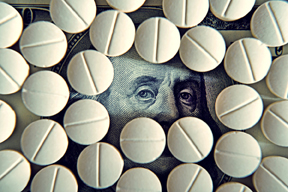

How to Control Rising Drug Costs
Spending on prescription drugs in the United States accounted for nearly 17 percent of total healthcare spending — with a price tag of $457 billion in 2015. And that’s only going up, unless serious change occurs.
The rapidly rising prices of prescription drugs, combined with increasingly higher cost-sharing, has shifted much of the costs to consumers. This is especially true for new therapies that, in some cases, cost hundreds of thousands of dollars for a single course of treatment.
Spending on prescription drugs in the United States totaled $457 billion in 2015, comprising nearly 17 percent of total health care spending. From now through 2018, prescription drug spending is projected to rise by an average of 7 percent annually, straining family budgets and putting treatment out of reach for many consumers, according to the Robert Wood Johnson Foundation report, “Promoting Access to Affordable Prescription Drugs.”
“Given the impact of high drug prices on consumers, payers, and government budgets, prescription drug costs are a matter of serious public concern,” the authors wrote.
President Trump Vows to Crack Down on Drug Costs
Amid growing concerns about the rising costs of drugs, President Donald Trump said during a recent speech to a joint session of Congress that he planned to crack down on the high prices drug companies charge.
“We should implement legal reforms that protect patients and doctors from unnecessary costs that drive up the price of insurance, and work to bring down the artificially high price of drugs, and bring them down immediately,” Trump said.
In a recent AARP article, John Hishta wrote this issue is critically important for all Americans, but especially for people over age 50 who “depend on prescription drugs to keep them healthy and who’ve been devastated by the price increases we’ve seen in recent years.”
The AARP noted several concerns regarding rising drug costs:
- Prices of drugs are getting out of control. Brand-name prescription drug prices rose nearly 130 percent faster than inflation did in 2015.
- Advertising is behind rising costs. The drug industry spent $5.4 billion on ads in 2015, a 19 percent increase over 2014, according to Kantar Media.
- Americans count on their prescriptions. A recent AARP survey found that three in four adults age 50-plus regularly take at least one prescription medication, and more than eight in 10 take at least two drugs. More than half of seniors take four or more drugs.
- Older Americans suffer the most from high prices. The average cost of a year’s supply of a prescription drug more than doubled to more than $11,000 since 2006.
- High drug prices raise costs for everyone. People with health coverage will pay higher health insurance premiums and deductibles.
“While the president didn’t offer any specific proposals on how to deal with these skyrocketing prices, we’re happy he sent a message to Congress that he expects them to follow his lead,” Hishta wrote. “AARP has long supported a wide variety of policies that will help reduce prescription drug prices, and we plan to let President Trump and Congress know exactly what they can do. For example, we believe that the secretary of Health and Human Services should have the authority to negotiate lower drug prices on behalf of millions of Medicare beneficiaries. In addition, we believe that we should reduce barriers to global price competition by allowing for the safe importation of lower-priced drugs. There is no reason for Americans to continue paying the highest prescription drug prices in the world.”
In March, U.S. Reps. Elijah Cummings, D-Md., and Peter Welch, D-Vt., met with Trump to discuss ways to combat high drug prices. They pitched a House bill that would expand the federal government’s ability to negotiate drug prices.
“He made it clear to us that he wanted to do something,” Cummings said.
Before the meeting, Trump tweeted that he was “working on a new system where there will be competition” in the drug industry. After meeting with Cummings and Welch, Trump said he wanted to work “in a bipartisan fashion to ensure prescription drug prices are more affordable for all Americans.”
Big Data and Technical Advances Are Helping Employers Reduce Health Insurance Costs
How to Control Rising Drug Costs
Many Americans ‘Not Worried Enough’ About Retirement
New Long-Term Care Insurance Policies Only Cost Seniors $100-$150 a Month
The information presented and conclusions within are based upon our best judgment and analysis. It is not guaranteed information and does not necessarily reflect all available data. Web addresses are current at time of publication but subject to change. SmartsPro Marketing and The Insurance 411 do not engage in the solicitation, sale or management of securities or investments, nor does it make any recommendations on securities or investments. This material may not be quoted or reproduced in any form without publisher's permission. All rights reserved. ©2017 The Insurance 411. http://theinsurance411.com Tel. 877-762-7877.